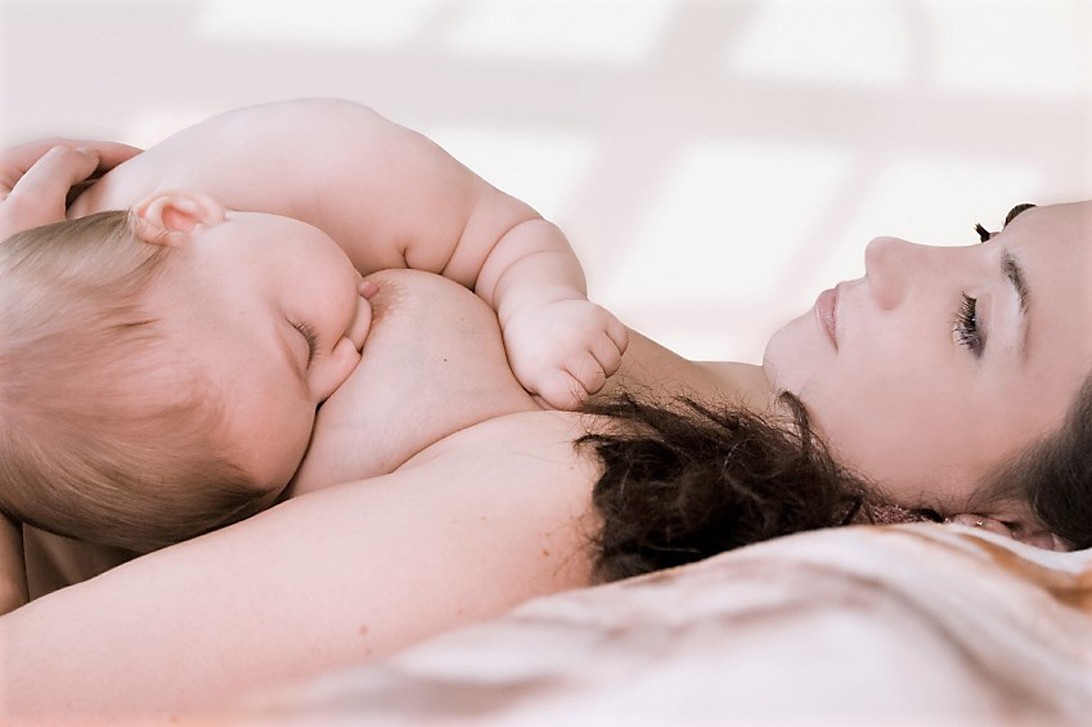A reasonable dictionary would have something like this: “Abreast (adverb): 1.side by side and facing the same way. Ex. “the path was wide enough for two people to walk abreast”. 2. alongside or level with something. Ex. “the cart came abreast of the Americans in their rickshaw”.
synonyms: in a row, side by side, alongside, level, abeam, on a level, beside each other, shoulder to shoulder, cheek by jowl. Ex. “the roads were full of bicycles, three or more abreast”.
All looks fine except this last example which goes against logic.
Before we explain why let’s have a look at its etymology: “breast (n.): Old English breost “breast, bosom; mind, thought, disposition,” from Proto-Germanic *breustam “breast” (cognates: Old Saxon briost, Old Frisian briast, Old Norsebrjost, Dutch borst, German brust, Gothic brusts), perhaps literally “swelling” and from PIE root *bhreus- “to swell, sprout” (cognates: Middle Irish bruasach “having a broad, strong chest,” Old Irish bruinne “breast”). The spelling conforms to the Scottish and northern England dialectal pronunciation. Figurative sense of “seat of the emotions” was in Old English.
So, nothing, really.
What about ‘abreast’?
“abreast (adv.): mid-15c., on brest, from a- (1) + breast (n.); the notion is of “with breasts in line.” To keep abreast in figurative sense of “stay up-to-date” is from 1650s.
Again nothing but this is what secondary etymology provides – the historical use of the word but nothing on the origin.
For that we have to turn to Arabic or Akkadian, both are daughters of the ancient linguistic grandmother “Ariba” or tongue of ancient Arabians (the better ancestors of Arabs): aḫia aḫia: abreast, side by side.
There’s a double serving here “aḫia aḫia” which means that the image, and Ariba is a language of images, is of two things that are alike, or a pair.
1. Let’s see what examples are provided by our ancient ancestors and muse at the simplicity of building ancient words:
2. aḫ abi: [Human → Family] uncle, father’ s brother;
3. aḫ ummi: [Human → Family] maternal uncle , mother’ s brother;
4. aḫ-abi: [Human → Family] a paternal uncle;
5. aḫ-ḫur: (t)hereafter; else, furthermore;
6. aḫāʾiš: together, each other, one another;
7. aḫāmiš: each other, one another, mutually;
8. aḫamma: apart, separately;
9. aḫannâ: [Humanities → Geography → Rivers] on this side, on this bank;
10. aḫāru: G. stat.: to be late, delayed D. to delay sth (trans.); to stay behind, delay (intrans.); stat. : to be overdue Š. to make late;
11. aḫāt abi* : [Human → Family] aunt, father’ s sister;
12. aḫāt aḫi * : [Human → Family] brother’ s sister;
13. aḫāt ummi * : [Human → Family] aunt, mother’ s sister;
14. aḫātatu: [Human → Family] little sister;
15. aḫātu: [Human → Family] sister.
16. aḫātūtu: [Human → Family] sisterhood
17. aḫātu (2): [Humanities → Geography] 1) (river, sea): a bank, a shore, a beach (?); 2): the sleeves (of a garment); 3) (moral transgression): the limit (?) / the line
If you want to understand how did our ancestors processed the world around them you have to think really simple, really, really simple. Some of the above examples are ancient talk at its best. Only thousands of years later our ancestors found it useful to invent words like “uncle, aunt, grandfather”, etc. Before that he was “father of my father”. Everybody understood what it meant and the same for other nouns.
Look at entry 17: One bank is called aḫātu “a bank, a shore”. The same word (15) means “sister” (in Arabic today). If we repeat the word twice: aḫātu aḫātu the meaning would be “sister sister”. If we exchange ‘sister’ for “breast” we would have “breast breast” or “abreast”.

Breast-feeding: Advice for New Mothers – Womens Magazine:
We are talking about a woman’s breast but men have breasts as well. The thing about breast is that they are always level, like the two banks of a river with a space separating them.
That’s why an example like “the roads were full of bicycles, three or more abreast” would have made our ancestors laugh because it is illogical. A river can’t have three banks nor can a woman have three breasts.
We covered the origins of “breast” in an earlier post:https://plus.google.com/+ThebookoforiginsNetAdel_S_Bishtawi/posts/FcgFavjFdgj
It is true that that the breasts of our ancient grandmas were sucked by both babies and men, so no change, really in the act of sucking but a huge change concerning something else. Breasts in ancient times were almost sacred. At times when no Bibles or Qurans were made available to swear on, women bared their breasts at court and swore on their breasts.
First, proof that women’s breasts were given high erotic marks by men, apparently equal to the pussy, so some may wonder what was so special about ancient breasts:
irtu: [Human → Body] chest, breast.
Primary etymology can tell you the root of this trilateral – *IR (IPA *’R). This is the most famous sexual word in history and the oldest. The root is a category, a morphological container, with enough words to fill a small dictionary: penis, cunt, bottom, breast, sex act, etc. From this root are words like “Eros: god of love, late 14c., from Greek eros (plural erotes), “god or personification of love,” literally “love,” from eran “to love,”erasthai “to love, desire,” which is of uncertain origin.”
“Of uncertain origin” no more. Had the guys opened any Arabic dictionary they would have found the word: “Arash: Ex. arashat between two men: enticed one against the other. Synonym: “tahreesh”. This last word is used to describe a man making advances to a woman or vice versa. If the root is preceded by a hamza, a short ‘a’, it would be the Arabic ‘aar’ (ayre): Penis.
A variation is with a ‘th’ “arath”. The word is emptied of its original sexual content and used figuratively to mean: “set people against each other; sow dissension among people; stir up discord between a man and a woman”, etc.
From the same root ‘erao’ “to be in love with, to desire passionately or sexually; erotic: 1650s, from French érotique (16c.), from Greek erotikos “caused by passionate love, referring to love,” from eros (genitive erotos) “sexual love” (see Eros). Earlier form was erotical (1620s);erogenous (adj.) “inducing erotic sensation or sexual desire,” 1889, from Greek eros “sexual love”; Erogenous zone attested by 1905; Erastus masc. proper name, Latin, literally “beloved,” from Greek erastos (looks from the same root as erasthai), verbal adjective of eran “to love” (see Eros).Erato: muse who presided over lyric poetry, literally “the Lovely,” from Greek erastos “loved, beloved; lovely, charming,” verbal adjective of eran “to love, to be in love with” (see Eros).

The second proof of sanctity of the breast is this:
ṣibtu tulê : [Religion] grasping breast in an oath ceremony.
It was explained in an earlier post that Akkadian “ṣertu”: [Animals] breast (woman), tit, teat nipple, udder” is so named because the breast looked to our ancestors like a pouch.
The word is in Arabic in two variations: ṣarʻ and ḍarʻ, the second was produced by a dotting mistake over the letter ṣ, which has a sound similar to ‘s’ in “sub”.
Both ṣarʻ and ḍarʻ have two different meanings:
1- In dual form two parallel points, like ‘abreast”.
2- Separately, ḍarʻ is “to implore, to prostrate oneself to God; implore God for mercy or something, forced to implore”, etc.
In exceptionally grave circumstances, women would bare their right breast, push it up towards the sky, look up and appeal for something urgent like food during famines or water during droughts. In other circumstances some would do the same to swear that a very serious accusation is false, and she’s swearing by her breasts that it is so.
A spontaneous scene like this was witnessed by this writer but baring breasts is an ancient practice by non-Arabs. Here’s a para from an article:
“Probably around 3,000 years ago. Women are displayed with exposed breasts in Minoan artwork from 1500 B.C. Some historians believe that these ancient women went topless only during religious rituals—bare-breasted, buxom goddesses have been worshipped since the dawn of civilization—but some of the artworks depict everyday activities, suggesting that bare breasts may have been commonplace. Just across the Mediterranean, ancient Egyptian women sported elaborate dresses that could either cover the breasts or leave them exposed, depending on the whim of the designer. Over the next few centuries, however, breasts become strictly private parts. Ancient Athenian women were wearing flowing, multi-layered robes that concealed the shape of the bosom by the middle of the first millennium B.C. Spartan attire was more risqué, exposing the female thigh, but breasts were always covered.”
Blame the Canaanites (Phoenicians) and their staunch ally – Abraham.
The practice looks ancient. Pushing a breast to the sky is not offering God to have a look. The words uttered later appear to be different from the original words. Because the word for “appeal” is the same for “breast” the ancient swearing meant something like “May God deprive me of milk or dry my breast if I’m lying”.
This is very serious. A mother would cease to be a mother for little babies and they may die. It is a life or death situation.
This writer is not aware of cases involving girls but bras in ancient times would have been problematic. The word in today’s Arabic for “bra” is something like “a chesty” implying it covers the whole chest. It has too many letters to be considered ancient.
Ancient Egyptian scenes have drawings of women fully dressed and girls with breasts shielded or party shielded by a semi circular covering hung around the neck.
Thank you.

New Kids Center
Last modified: December 30, 2022



